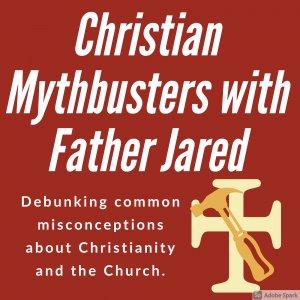Christian Mythbusters

Halloween, Spirits, and Día de los Muertos
This is Father Jared Cramer from St. John’s Episcopal Church in Grand Haven, Michigan, here with today’s edition of Christian Mythbusters, a regular segment I offer to counter some common misconceptions about the Christian faith.
Halloween is coming! At least, that is what my five-year old daughter has told me almost every day for the past two weeks. But now, this weekend, the wait will be over, and all spooky ghosts and ghouls will be on the prowl either Saturday or Sunday, looking for some tricks or treats.
When I was growing up as a Christian, though, Halloween was a bit… uneven. On one side of my family, Halloween was seen as the devil’s holiday and there was great danger in observing it. On the other side, it was just fun to dress up, no matter the costume. One year, I dressed as the devil for Halloween, but then had to change costumes before going to the church Halloween party.
So, I thought this might be a good week to break the myths surrounding Christianity and Halloween.
When the month of October turns into November, the Western church celebrates a sacred time often called Allhallowtide. The term “Allhallowtide” is derived from two words in Old English, the word halig (which means holy and is a synonym for saint) and the word tide (which means time). The celebration of Allhallowtide begins on October 31stwith All Hallows Eve (the Eve of All Saints’, often shortened to Hallowe’en). It then continues with All Saints’ Day on November 1 and the Commemoration of All Faithful Departed (commonly known as All Souls’ Day) on November 2. The way in which this sacred time is observed varies around the world, but most Christians see it as an opportunity to celebrate Christ’s triumph over death and our continued bonds to our loved ones who have died.
When we look at Christianity in the British Isles in the Middle Ages, we see how these celebrations began interacting with the pagan Celtic holiday of Samhain, which fell each year in early November. Samhain marked the time at which the harvest had ended, and the days began growing darker. The Celtic people believed that during this time the boundaries between our world and the world of the dead thinned. The souls of the dead would even revisit their homes, seeking hospitality. And so, people would set an extra place at the dinner table to welcome them.
Throughout the Middle Ages, the importance of these festivals spread throughout Europe. It was common to burn candles in your home in Austria and England to help guide souls back to their homes. In other countries, groups of poor people would travel door-to-door collecting soul cakes in exchange for praying for the dead. These traditions developed in Spain as well. In Spain, the tradition of bringing pan de ánimas (spirit bread) to the graves of loved ones was an important part of All Souls’ Day. Christians would also cover the graves of loved ones with flowers and light candles to guide the departed home.
As the Catholic Church arrived in Mexico with the sixteenth-century Conquistadors, they brought with them Spanish and Catholic celebrations surrounding All Saints’ and All Souls’. The Mesoamerican Indigenous celebrations of the dead in the fall began to blend with Spanish and Catholic traditions surrounding the saints and all faithful departed and before too long the modern Día de los Muertos was born.
On Día de los Muertos, just like Samhain and All Souls’ Day in Ireland and England, those who celebrate this sacred time believe the border between the spirit world and our world dissolves and the souls of the dead can return to the living world to once again commune with family members for a brief period.
Today the sacred time of All Hallows Eve, All Saints’ Day, and All Souls’ Day is celebrated in many different ways in congregations across the church and in many denominations. You can find out more about this history, and especially about the observance of Día de los Muertos in a small booklet I wrote with our church’s Office of Latino/Hispanic Ministries. It’s online at http://sjegh.com/muertos.
But, no matter your cultural background, there’s no need to be scared or anxious about Christians observing Halloween. A good scary movie or a fright in a haunted house on Halloween tends to make you feel more alive, which can be a fun and good thing, giving you appreciation for the life you have which is, of course, a gift from God.
Maybe also take some time during this sacred season to remember the great heroes of faith, to remember those you love who have died. Because the truth is that nothing—not death, not even ghosts and ghouls—can separate us from the love of God which binds us together in Christ.
Thanks for being with me. To find out more about my parish, you can go to sjegh.com. Until next time, remember, protest like Jesus, love recklessly, and live your faith out in a community that accepts you but also challenges you to be better tomorrow than you are today.






 Visit Podcast Website
Visit Podcast Website RSS Podcast Feed
RSS Podcast Feed Subscribe
Subscribe
 Add to MyCast
Add to MyCast